We included HMH Into Math Grade 8 Answer Key PDF Module 11 Review to make students experts in learning maths.
HMH Into Math Grade 8 Module 11 Review Answer Key
Vocabulary
For Problems 1-3, choose the correct term from the Vocabulary box to complete each sentence.
Vocabulary
hypotenuse
leg
Pythagorean Theorem
Pythagorean triple
Question 1.
The ____________ describes the relationship leg among the lengths of the sides of any right triangle.
Answer:
Pythagorean Theorem,
Explanation:
The Pythagorean Theorem describes the relationship leg among the lengths of the sides of any right triangle.
Question 2.
A _____________ of a right triangle is one of the sides that forms the right angle.
Answer:
hypotenuse,
Explanation:
A hypotenuse of a right triangle is one of the sides that forms the right angle.
Question 3.
A _____________ is a set of three positive integers that could be the side lengths of a right triangle.
Answer:
Pythagorean triple,
Explanation:
A Pythagorean triple is a set of three positive integers that
could be the side lengths of a right triangle.
Question 4.
Write the converse of this statement: If a triangle has a right angle, then it is a right triangle.
Answer:
Converse: If a triangle is right triangle then it has a right angle,
Explanation:
Given to write the converse of this statement: If a triangle has a right angle, then it is a right triangle so it is Converse: If a triangle is right triangle then it has a right angle.
Concepts and Skills
Question 5.
Which set of side lengths could form a right triangle?
(A) 5 cm, 5 cm, and 10 cm
(B) 6 cm, 7 cm, and 8 cm
(C) 8 cm, 15 cm, and 17 cm
(D) 9 cm, 12 cm, and 16 cm
Answer:
(C) 8 cm, 15 cm, and 17 cm and
(D) 9 cm, 12 cm, and 16 cm,
Explanation:
To find which set of side lengths could form a right triangle is checking with bit(A) 5 cm, 5 cm, and 10 cm we have (5)2 + (5)2 = 102, 25 + 25 = 100, as 50 ≠ 100, checking with bit(B) 6 cm, 7 cm, and 8 cm we have (6)2 + (7)2 = 82, 36 + 49 = 64, as 85 ≠ 64,
checking with bit(C) 8 cm, 15 cm, and 17 cm we have
(8)2 + (15)2 = 172, 64 + 225 = 289, as 289 = 289,
now checking with bit(D) 9 cm, 12 cm, and 16 cm we have (9)2 + (12)2 = 162,
81 + 144 = 225 as 225 =225, therefore bits (C) and (D) set of side lengths could form a right triangle.
Question 6.
Use Tools The diagram represents a set of beams that form part of a bridge support. Label \(\overline{A B}\) and \(\overline{B D}\) with their lengths, rounded to the nearest foot. State what strategy and tool you will use to answer the question, explain your choice, and then find the answer.
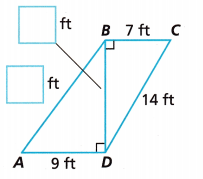
Answer:
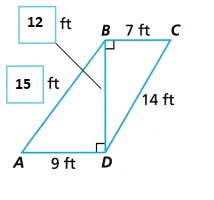
Explanation:
To find the distance of BD we calculate as BD2 = (14)2 – 72,
BD2 = 196 – 49 = 147, So BD is equal to square root of 147 = 12.12 nearly 12 ft, Now the distance of AB is AB2 = (12)2 + 92, AB2 = 144 + 81 = 225, So AB is equal to square root of
225 = 15 ft, Used Tools the diagram represented a set of beams that form part of a bridge support.
Labelled \(\overline{A B}\) as 15 ft and\(\overline{B D}\) as 12 ft with their lengths and rounded to the nearest foot. Strategy used as both are right triangles is Pythagorean theorem.
For Problems 7 and 8, determine the unknown side length of each right triangle to the nearest hundredth.
Question 7.
What is the length of \(\overline{J L}\)?
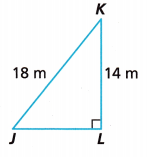
__________ meters
Answer:
The length of \(\overline{J L}\) is 11 meters,
Explanation:
Given side length of triangle KJL as KL 14 m and KJ as 18 m as triangle is right triangle applying
Pythagorean theorem to find the length of JL as JL2 = (18)2 – 142,
JL2 = 324 -196 = 128, So JL is equal to square root of 128 = 11.31 nearly 11 meters.
Question 8.
What is the length of \(\overline{S T}\)?
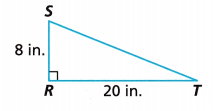
___________ inches
Answer:
The length of \(\overline{S T}\) is 22 in,
Explanation:
Given side length of triangle SRT as SR 8 in. and RT as 20 in. as triangle is right triangle applying
Pythagorean theorem to find the length of ST as ST2 = 82 + 202,
ST2 = 64 + 400 = 464, So ST is equal to square root of 464 = 21.54 nearly 22 in.
Question 9.
The steps shown can be used to prove the Pythagorean Theorem.
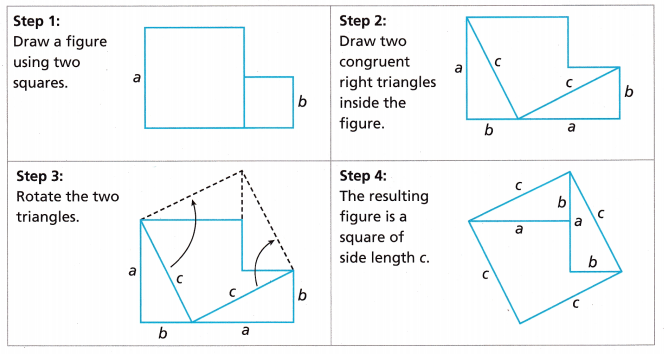
Explain how the steps prove the Pythagorean Theorem. Hint: Write expressions for the total area of the figures in Step 1 and in Step 4.
Answer:
c2 = a2 + b2 ,
Explanation:
Asking to prove the Pythagorean Theorem as a2 + b2 = c2, So
Step 1: Drawn a figure using two squares one big square with side a we have area of
square as a2 and small square with side b and area as b2, total area is a2 + b2.
Step 2: Drawn two congruent right triangles inside the figure as shown above with hypotenuse as c,
Step 3: Rotated the two triangles as shown above,
Step 4: The resulting figure is a square of side length c.
Therefore the area of resulting sqaure is a2 + b2 = c2 which is equal to a2 + b2. hence proved.
Question 10.
Which set of side lengths could form a right triangle?
(A) 3ft, 5ft, 12ft
(B) 5ft, 12ft, 13ft
(C) 12ft, 13ft, 16ft
(D) 13ft, 16ft, 24ft
Answer:
(B) 5ft, 12ft, 13ft,
Explanation:
To find which set of side lengths could form a right triangle is checking with bit(A) 3ft, 5ft, 12ft we have (3)2 + (5)2 = 122, 9 + 25 = 144, as 34 ≠ 144, checking with bit (B) 5ft, 12ft, 13ft we have
(5)2 + (12)2 = 132, 25 + 144 = 169, as 169 =169, checking with bit(C) 12ft, 13ft, 16ft we have
(12)2 + (13)2 = 162, 144 + 169 = 256, as 313 ≠ 256, now checking with bit(D) 13ft, 16ft, 24ft we have
(13)2 + (16)2 = 242, 169 + 256 = 576, as 425 ≠ 576, therefore bit (B) lengths could form a right triangle.
Question 11.
Meg is making a scale model of an Egyptian pyramid. The model is a right square pyramid as shown. To the nearest centimeter, what is the base length b of the model?
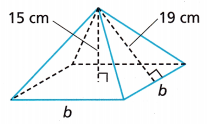
(A) 12 cm
(B) 16 cm
(C) 23 cm
(D) 48 cm
Answer:
(A) 12 cm,
Explanation:
Given Meg is making a scale model of an Egyptian pyramid. The model is a right square pyramid as shown above. The nearest centimeter is the base length b of the model is as it is right triangle applying Pythagorean theorem as192 = b2 + 152, b2 = 361 – 225 = 136, So b is equal to square root of
11.66 nearly 12 cm which matches with bit (A).
For Problems 12-14, determine the distance between the pair of points, to the nearest hundredth of a unit.
Question 12.
A(-2, 1) and B(3, 5) ________________ units
Answer:
Distance between A and B is approximately 6 units,
Explanation:
Given A(-2, 1) and B(3, 5) the distance between the pair of points be x so applying Pythagorean theorem as x2 = (3 – (-2))2 + (5 – 1)2, x2 = 25 + 16 = 41, So x is equal to square root of
41 = 6.40 nearly 6 units.
Question 13.
C(-5, -2) and D(0, -4) _______________ units
Answer:
Distance between C and D is approximately 5 units,
Explanation:
Given C(-5, -2) and D(0, -4) the distance between the pair of points be x so applying Pythagorean theorem as x2 = (0 – (-5))2 + (-4 – (-2))2, x2 = 25 + 4 = 29, So x is equal to square root of
29 = 5.38 nearly 5 units.
Question 14.
E(7, 3) and F(-2, 6) _______________ units
Answer:
Distance between E and F is approximately 9 units,
Explanation:
Given E(7, 3) and F(-2, 6) the distance between the pair of points be x so applying Pythagorean theorem as x2 = (-2 – 7)2 + (6 – 3)2, x2 = 81 + 9 = 90, So x is equal to square root of
90 = 9.48 nearly 9 units.